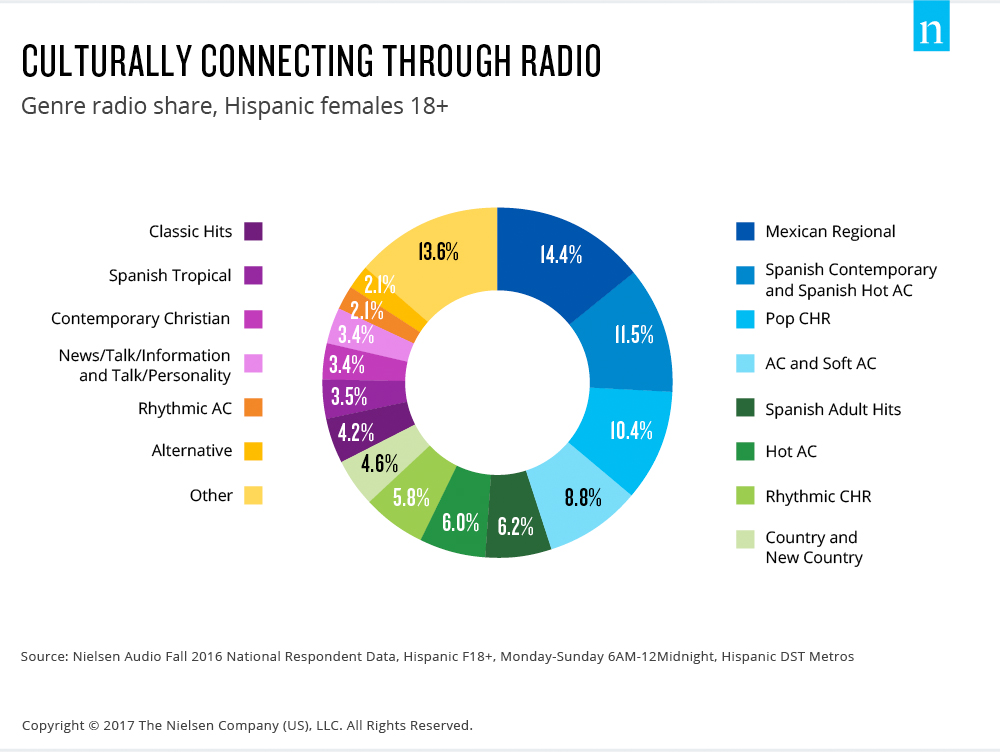Latinas’ Cultural Identity Manifests Through Music
November 30, 2017
![]() Today’s Latina is ambicultural, seamlessly identifying as American while also retaining strong connections to her native culture. One of the ways she stays connected to her roots is through music. Whether it’s on radio or streaming services, Latinas’ consumption behavior and preferences reflect how their lives revolve around music.
Today’s Latina is ambicultural, seamlessly identifying as American while also retaining strong connections to her native culture. One of the ways she stays connected to her roots is through music. Whether it’s on radio or streaming services, Latinas’ consumption behavior and preferences reflect how their lives revolve around music.
TRADITIONAL AND DIGITAL RADIO ARE PREFERRED
Traditional AM/FM radio has a significant reach among Latinas. Ninety-four percent of Latinas—or 18 million—listen to radio each week, and they listen for more time per week (13 hours and nine minutes) than non-Hispanic women (12 hours and 52 minutes). This high level of radio consumption, coupled with the rapidly increasing Latina population, has led to a robust Spanish-language and culturally relevant radio genre selection.

Seventy-three percent of Latinas agree that their cultural heritage is an important part of who they are, and 75% agree that they enjoy maintaining traditions. One of the primary ways Latinas maintain ties to their native culture is through language.
Although only 34% of Hispanic women are foreign-born, 74% of Latinas over the age of five speak a language other than English at home—meaning Latinas are increasingly bilingual. And the top radio genre preferences among Latinas reflects her bilingual abilities. The top two radio genres among Latinas are Mexican regional (14.4%), followed by Spanish contemporary (11.5%). However, not far behind is contemporary hits radio (10.4%), which shows how she identifies strongly with U.S. popular music as well.
While traditional AM/FM radio has a huge reach with Latinas, she is also adopting digital platforms for her music consumption. Forty-four percent of Latinas listen to an online music service like Pandora or Spotify at a rate 10% higher than non-Hispanic women, and Hispanic women are 35% more likely to download music from an online service like iTunes or Google Play.
INFLUENTIAL LATINA STARS
When examining Latinas’ music consumption, it is impossible to ignore the Latinas who have taken the U.S. mainstream by storm. Artists like Jennifer Lopez and Shakira have experienced mainstream success, having sold tens of millions of albums in the U.S. Their influence can also be measured via Nielsen’s N-score, which measures the overall marketability of celebrities. Shakira commands an N-score of 94 as determined by Hispanics, and Lopez has a score of 92. These are two of the top scores among Hispanics, and they speak to how closely Latinos identify with the celebrities who share their backgrounds.
Lopez, in particular, has a brand that extends beyond music. She owns a media and product empire that includes global television and film rights, as well as multiple fashion and fragrance lines. Lopez’s crossover success, and the success of other Latina stars, has paved the way for emerging stars who could define Latina star power in the years to come. These Latina influencers can be important advocates for brands and advertisers seeking to make meaningful, culturally relevant connections with not only Latinas and all Hispanics, but mainstream consumers as well.




























